| Listing 1 - 6 of 6 |
Sort by
|
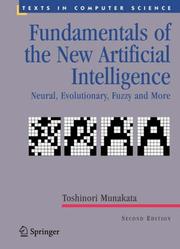
ISBN: 1846288398 9781846288388 184628838X 9781846288395 Year: 2008 Publisher: London : Springer London : Imprint: Springer,
Abstract | Keywords | Export | Availability | Bookmark
 Loading...
Loading...Choose an application
- Reference Manager
- EndNote
- RefWorks (Direct export to RefWorks)
Artificial intelligence—broadly defined as the study of making computers perform tasks that require human intelligence—has grown rapidly as a field of research and industrial application in recent years. Whereas traditionally, AI used techniques drawn from symbolic models such as knowledge-based and logic programming systems, interest has grown in newer paradigms, notably neural networks, genetic algorithms, and fuzzy logic. The significantly updated second edition of Fundamentals of the New Artificial Intelligence thoroughly covers the most essential and widely employed material pertaining to neural networks, genetic algorithms, fuzzy systems, rough sets, and chaos. In particular, this unique textbook explores the importance of this content for real-world applications. The exposition reveals the core principles, concepts, and technologies in a concise and accessible, easy-to-understand manner, and as a result, prerequisites are minimal: A basic understanding of computer programming and mathematics makes the book suitable for readers coming to this subject for the first time. Topics and features: Retains the well-received features of the first edition, yet clarifies and expands on the topic • Features completely new material on simulated annealing, Boltzmann machines, and extended fuzzy if-then rules tables [NEW] • Emphasizes the real-world applications derived from this important area of computer science • Provides easy-to-comprehend descriptions and algorithms • Updates all references, for maximum usefulness to professors, students, and other readers [NEW] • Integrates all material, yet allows each chapter to be used or studied independently This invaluable text and reference is an authoritative introduction to the subject and is therefore ideal for upper-level undergraduates and graduates studying intelligent computing, soft computing, neural networks, evolutionary computing, and fuzzy systems. In addition, the material is self-contained and therefore valuable to researchers in many related disciplines. Professor Munakata is a leading figure in this field and has given courses on this topic extensively.
Computer science. --- Data mining. --- Artificial intelligence. --- Pattern recognition. --- Computer Science. --- Artificial Intelligence (incl. Robotics). --- Data Mining and Knowledge Discovery. --- Pattern Recognition. --- AI (Artificial intelligence) --- Artificial thinking --- Electronic brains --- Intellectronics --- Intelligence, Artificial --- Intelligent machines --- Machine intelligence --- Thinking, Artificial --- Bionics --- Cognitive science --- Digital computer simulation --- Electronic data processing --- Logic machines --- Machine theory --- Self-organizing systems --- Simulation methods --- Fifth generation computers --- Neural computers --- Design perception --- Pattern recognition --- Form perception --- Perception --- Figure-ground perception --- Algorithmic knowledge discovery --- Factual data analysis --- KDD (Information retrieval) --- Knowledge discovery in data --- Knowledge discovery in databases --- Mining, Data --- Database searching --- Informatics --- Science --- Neural networks (Computer science) --- Artificial neural networks --- Nets, Neural (Computer science) --- Networks, Neural (Computer science) --- Neural nets (Computer science) --- Artificial intelligence --- Natural computation --- Soft computing --- Information Technology --- Artificial Intelligence --- Optical pattern recognition. --- Artificial Intelligence. --- Optical data processing --- Pattern perception --- Perceptrons --- Visual discrimination
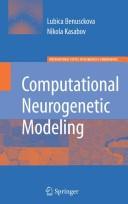
ISBN: 9780387483559 0387483535 9780387483535 1441943013 0387483551 Year: 2007 Publisher: New York : Springer,
Abstract | Keywords | Export | Availability | Bookmark
 Loading...
Loading...Choose an application
- Reference Manager
- EndNote
- RefWorks (Direct export to RefWorks)
Computational Neurogenetic Modeling Integrating Bioinformatics and Neuroscience Data, Information and Knowledge via Computational Intelligence Lubica Benuskova and Nikola Kasabov With the presence of a great amount of both brain and gene data related to brain functions and diseases, it is required that sophisticated computational neurogenetic models be created to facilitate new discoveries that will help researchers in understanding the brain in its complex interaction between genetic and neuronal processes. Initial steps in this direction are underway, using the methods of computational intelligence to integrate knowledge, data and information from genetics, bioinfomatics and neuroscience. Computational Neurogenetic Modeling offers the knowledge base for creating such models covering the areas of neuroscience, genetics, bioinformatics and computational intelligence. This multidisciplinary background is then integrated into a generic computational neurogenetic modeling methodology. computational neurogenetic models offer vital applications for learning and memory, brain aging and Alzheimer’s disease, Parkinson’s disease, mental retardation, schizophrenia and epilepsy. Key Topics Include: Brain Information Processing Methods of Computational Intelligence, Including: Artificial Neural Networks Evolutionary Computation Evolving Connectionist Systems Gene Information Processing Methodologies for Building Computational Neurogenetic Models Applications of CNGM for modeling brain functions and diseases Computational Neurogenetic Modeling is essential reading for postgraduate students and researchers in the areas of information sciences, artificial intelligence, neurosciences, bioinformatics and cognitive sciences. This volume is structured so that every chapter can be used as a reading material for research oriented courses at a postgraduate level. About the Authors: Lubica Benuskova is currently Senior Research Fellow at the Knowledge Engineering & Discovery Research Institute (KEDRI, www.kedri.info), Auckland University of Technology (AUT) in Auckland, New Zealand. She is also Associate Professor of Applied Informatics at the Faculty of Mathematics, Physics and Informatics at Comenius (Komensky) University in Bratislava, Slovakia. Her research interests are in the areas of computational neuroscience, cognitive science, neuroinformatics, computer and information sciences. Nikola Kasabov is the Founding Director and Chief Scientist of KEDRI, and a Professor and Chair of Knowledge Engineering at the School of Computer and Information Sciences at AUT. He is a leading expert in computational intelligence and knowledge engineering and has published more than 400 papers, books and patents in the areas of neural and hybrid intelligent systems, bioinformatics and neuroinformatics, speech-, image and multimodal information processing. He is a Fellow of the Royal Society of New Zealand, Senior Member of IEEE, Vice President of the International Neural Network Society and a Past President of the Asia-Pacific Neural Network Assembly.
Engineering. --- Biomedical Engineering. --- Bioinformatics. --- Neurosciences. --- Human Genetics. --- Information Systems and Communication Service. --- Biophysics and Biological Physics. --- Human genetics. --- Information systems. --- Biomedical engineering. --- Ingénierie --- Génétique humaine --- Neurosciences --- Bio-informatique --- Génie biomédical --- Computational neuroscience. --- Neural networks (Computer science). --- Neural networks (Neurobiology). --- Neurogenetics -- Computer simulation. --- Neurogenetics -- Mathematical models. --- Neurogenetics --- Computational neuroscience --- Neural networks (Computer science) --- Neural networks (Neurobiology) --- Diseases --- Mathematical Concepts --- Musculoskeletal and Neural Physiological Phenomena --- Pattern Recognition, Automated --- Computing Methodologies --- Biology --- Models, Biological --- Information Science --- Phenomena and Processes --- Biological Science Disciplines --- Models, Theoretical --- Neural Networks (Computer) --- Nervous System Physiological Phenomena --- Artificial Intelligence --- Computational Biology --- Nervous System Diseases --- Models, Genetic --- Natural Science Disciplines --- Investigative Techniques --- Analytical, Diagnostic and Therapeutic Techniques and Equipment --- Disciplines and Occupations --- Human Anatomy & Physiology --- Health & Biological Sciences --- Neuroscience --- Biomedical Engineering --- Mathematical models --- Computer simulation --- Information storage and retrieval systems --- Systèmes d'information --- Mathematical models. --- Computer simulation. --- Biological neural networks --- Nets, Neural (Neurobiology) --- Networks, Neural (Neurobiology) --- Neural nets (Neurobiology) --- Artificial neural networks --- Nets, Neural (Computer science) --- Networks, Neural (Computer science) --- Neural nets (Computer science) --- Computational neurosciences --- Nervous system --- Genetic aspects --- Computers. --- Computational Biology/Bioinformatics. --- Cognitive neuroscience --- Neurobiology --- Neural circuitry --- Artificial intelligence --- Natural computation --- Soft computing --- Computational biology --- Genetics --- Biomedical Engineering and Bioengineering. --- Heredity, Human --- Human biology --- Physical anthropology --- Neural sciences --- Neurological sciences --- Medical sciences --- Bio-informatics --- Biological informatics --- Information science --- Systems biology --- Clinical engineering --- Medical engineering --- Bioengineering --- Biophysics --- Engineering --- Medicine --- Data processing --- Automatic computers --- Automatic data processors --- Computer hardware --- Computing machines (Computers) --- Electronic brains --- Electronic calculating-machines --- Electronic computers --- Hardware, Computer --- Computer systems --- Cybernetics --- Machine theory --- Calculators --- Cyberspace
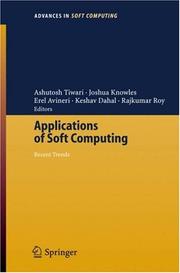
ISBN: 9783540362661 3540291237 9783540291237 9786612823503 1282823507 3540362665 Year: 2006 Publisher: Berlin ; New York : Springer,
Abstract | Keywords | Export | Availability | Bookmark
 Loading...
Loading...Choose an application
- Reference Manager
- EndNote
- RefWorks (Direct export to RefWorks)
Soft Computing is a complex of methodologies that embraces approximate reasoning, imprecision, uncertainty and partial truth in order to mimic the remarkable human capability of making decisions in real-life, ambiguous environments. Soft Computing has therefore become popular in developing systems that encapsulate human expertise. 'Applications of Soft Computing: Recent Trends' contains a collection of papers that were presented at the 10th Online World Conference on Soft Computing in Industrial Applications, held in September 2005. This carefully edited book provides a comprehensive overview of the recent advances in the industrial applications of soft computing and covers a wide range of application areas, including optimisation, data analysis and data mining, computer graphics and vision, prediction and diagnosis, design, intelligent control, and traffic and transportation systems. The book is aimed at researchers and professional engineers who are engaged in developing and applying intelligent systems. It is also suitable as wider reading for science and engineering postgraduate students.
Engineering. --- Appl.Mathematics/Computational Methods of Engineering. --- Artificial Intelligence (incl. Robotics). --- Applications of Mathematics. --- Information Systems Applications (incl.Internet). --- Information systems. --- Artificial intelligence. --- Mathematics. --- Engineering mathematics. --- Ingénierie --- Intelligence artificielle --- Mathématiques --- Mathématiques de l'ingénieur --- Information storage and retrieval systems --- Systèmes d'information --- Fuzzy systems -- Industrial applications -- Congresses. --- Neural networks (Computer science) -- Industrial applications -- Congresses. --- Soft computing -- Industrial applications -- Congresses. --- Soft computing --- Neural networks (Computer science) --- Fuzzy systems --- Civil Engineering --- Computer Science --- Applied Mathematics --- Engineering & Applied Sciences --- Civil & Environmental Engineering --- Industrial applications --- Systems, Fuzzy --- Artificial neural networks --- Nets, Neural (Computer science) --- Networks, Neural (Computer science) --- Neural nets (Computer science) --- Computer science. --- Applied mathematics. --- Computer Science. --- Information Systems Applications (incl. Internet). --- System analysis --- Fuzzy logic --- Artificial intelligence --- Natural computation --- Artificial Intelligence. --- Mathematical and Computational Engineering. --- Math --- Science --- Engineering --- Engineering analysis --- Mathematical analysis --- AI (Artificial intelligence) --- Artificial thinking --- Electronic brains --- Intellectronics --- Intelligence, Artificial --- Intelligent machines --- Machine intelligence --- Thinking, Artificial --- Bionics --- Cognitive science --- Digital computer simulation --- Electronic data processing --- Logic machines --- Machine theory --- Self-organizing systems --- Simulation methods --- Fifth generation computers --- Neural computers --- Mathematics --- Application software. --- Application computer programs --- Application computer software --- Applications software --- Apps (Computer software) --- Computer software
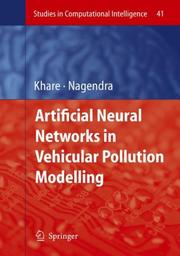
ISBN: 9783540374183 3540374175 9786610700325 1280700327 3540374183 9783540374176 Year: 2007 Volume: 41 Publisher: Berlin, Heidelberg Springer-Verlag Berlin Heidelberg
Abstract | Keywords | Export | Availability | Bookmark
 Loading...
Loading...Choose an application
- Reference Manager
- EndNote
- RefWorks (Direct export to RefWorks)
Artificial neural networks (ANNs), which are parallel computational models, comprising of interconnected adaptive processing units (neurons) have the capability to predict accurately the dispersive behavior of vehicular pollutants under complex environmental conditions. This book aims at describing step-by-step procedure for formulation and development of ANN based VP models considering meteorological and traffic parameters. The model predictions are compared with existing line source deterministic/statistical based models to establish the efficacy of the ANN technique in explaining frequent dispersion complexities in urban areas. The book is very useful for hardcore professionals and researchers working in problems associated with urban air pollution management and control.
Air pollution. Air purification --- analyse (wiskunde) --- Computer. Automation --- robots --- toegepaste wiskunde --- Transport engineering --- numerieke analyse --- Mathematics --- Nature protection --- Engineering sciences. Technology --- Artificial intelligence. Robotics. Simulation. Graphics --- luchtverontreiniging --- ingenieurswetenschappen --- algoritmen --- transport --- Air --- Automobiles --- Neural networks (Computer science) --- Pollution --- Mathematical models --- Motors --- Exhaust gas --- Engineering mathematics. --- Artificial intelligence. --- Engineering. --- Environmental protection. --- Mathematics. --- Mathematical and Computational Engineering. --- Artificial Intelligence. --- Automotive Engineering. --- Atmospheric Protection/Air Quality Control/Air Pollution. --- Applications of Mathematics. --- Computational Intelligence. --- Math --- Science --- Environmental quality management --- Protection of environment --- Environmental sciences --- Applied ecology --- Environmental engineering --- Environmental policy --- Environmental quality --- Construction --- Industrial arts --- Technology --- AI (Artificial intelligence) --- Artificial thinking --- Electronic brains --- Intellectronics --- Intelligence, Artificial --- Intelligent machines --- Machine intelligence --- Thinking, Artificial --- Bionics --- Cognitive science --- Digital computer simulation --- Electronic data processing --- Logic machines --- Machine theory --- Self-organizing systems --- Simulation methods --- Fifth generation computers --- Neural computers --- Engineering --- Engineering analysis --- Mathematical analysis --- Applied mathematics. --- Automotive engineering. --- Air pollution. --- Computational intelligence. --- Intelligence, Computational --- Artificial intelligence --- Soft computing --- Air contaminants --- Air pollutants --- Air pollution --- Air pollution control --- Air toxics --- Airborne pollutants --- Atmosphere --- Contaminants, Air --- Control of air pollution --- Pollutants, Air --- Toxics, Air --- Air quality --- Atmospheric deposition --- Control --- Mathematical models. --- Artificial neural networks --- Nets, Neural (Computer science) --- Networks, Neural (Computer science) --- Neural nets (Computer science) --- Natural computation --- Autos (Automobiles) --- Cars (Automobiles) --- Gasoline automobiles --- Motorcars (Automobiles) --- Motor vehicles --- Transportation, Automotive --- Air - Pollution - Mathematical models --- Automobiles - Motors - Exhaust gas - Mathematical models
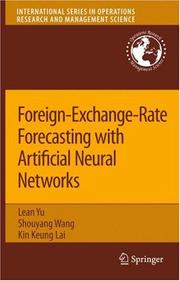
ISBN: 9780387717203 0387717196 9780387717197 038771720X Year: 2007 Publisher: New York, NY : Springer US : Imprint: Springer,
Abstract | Keywords | Export | Availability | Bookmark
 Loading...
Loading...Choose an application
- Reference Manager
- EndNote
- RefWorks (Direct export to RefWorks)
The foreign exchange market is one of the most complex dynamic markets with the characteristics of high volatility, nonlinearity and irregularity. Since the Bretton Woods System collapsed in 1970s, the fluctuations in the foreign exchange market are more volatile than ever. Furthermore, some important factors, such as economic growth, trade development, interest rates and inflation rates, have significant impacts on the exchange rate fluctuation. Meantime, these characteristics also make it extremely difficult to predict foreign exchange rates. Therefore, exchange rates forecasting has become a very important and challenge research issue for both academic and industrial communities. In this monograph, the authors try to apply artificial neural networks (ANNs) to exchange rates forecasting. Selection of the ANN approach for exchange rates forecasting is because of ANNs’ unique features and powerful pattern recognition capability. Unlike most of the traditional model-based forecasting techniques, ANNs are a class of data-driven, self-adaptive, and nonlinear methods that do not require specific assumptions on the und- lying data generating process. These features are particularly appealing for practical forecasting situations where data are abundant or easily available, even though the theoretical model or the underlying relationship is - known. Furthermore, ANNs have been successfully applied to a wide range of forecasting problems in almost all areas of business, industry and engineering. In addition, ANNs have been proved to be a universal functional approximator that can capture any type of complex relationships.
Economics/Management Science. --- Finance /Banking. --- Quantitative Finance. --- Operations Research/Decision Theory. --- Artificial Intelligence (incl. Robotics). --- Computational Mathematics and Numerical Analysis. --- Computing Methodologies. --- Economics. --- Electronic data processing. --- Artificial intelligence. --- Finance. --- Computer science --- Banks and banking. --- Economie politique --- Informatique --- Intelligence artificielle --- Finances --- Banques --- Mathematics. --- Mathématiques --- Foreign exchange rates -- Forecasting. --- Foreign exchange rates -- Mathematical models. --- Neural networks (Computer science). --- Finance --- International Finance --- Investment & Speculation --- Banking --- Finance - General --- Business & Economics --- AA / International- internationaal --- 305.92 --- 333.450 --- Foreign exchange rates --- -Neural networks (Computer science) --- 332.456 --- Artificial neural networks --- Nets, Neural (Computer science) --- Networks, Neural (Computer science) --- Neural nets (Computer science) --- Artificial intelligence --- Natural computation --- Soft computing --- Exchange rates --- Fixed exchange rates --- Flexible exchange rates --- Floating exchange rates --- Fluctuating exchange rates --- Foreign exchange --- Rates of exchange --- Econometrie van de internationale handel. Handelsbalans, betalingsbalans. Wissel. --- Theorie van het deviezenverkeer. Theorie van de koopkrachtpariteit. --- Forecasting --- Rates --- Neural networks (Computer science) --- Forecasting. --- Operations research. --- Decision making. --- Economics, Mathematical. --- Computer mathematics. --- Macroeconomics. --- Finance, general. --- Macroeconomics/Monetary Economics//Financial Economics. --- Operation Research/Decision Theory. --- Economics --- Computer mathematics --- Discrete mathematics --- Electronic data processing --- Mathematical economics --- Econometrics --- Mathematics --- AI (Artificial intelligence) --- Artificial thinking --- Electronic brains --- Intellectronics --- Intelligence, Artificial --- Intelligent machines --- Machine intelligence --- Thinking, Artificial --- Bionics --- Cognitive science --- Digital computer simulation --- Logic machines --- Machine theory --- Self-organizing systems --- Simulation methods --- Fifth generation computers --- Neural computers --- Deciding --- Decision (Psychology) --- Decision analysis --- Decision processes --- Making decisions --- Management --- Management decisions --- Choice (Psychology) --- Problem solving --- Operational analysis --- Operational research --- Industrial engineering --- Management science --- Research --- System theory --- Funding --- Funds --- Currency question --- Methodology --- Decision making --- Artificial Intelligence. --- Economics, Mathematical . --- Financial applications. --- Data processing --- Econometrie van de internationale handel. Handelsbalans, betalingsbalans. Wissel --- Theorie van het deviezenverkeer. Theorie van de koopkrachtpariteit

ISBN: 9780387682815 9780387682822 0387682813 0387952594 1441923942 0387682821 1475735049 1475735022 9780387952598 Year: 2007 Publisher: New York Springer
Abstract | Keywords | Export | Availability | Bookmark
 Loading...
Loading...Choose an application
- Reference Manager
- EndNote
- RefWorks (Direct export to RefWorks)
Probabilistic graphical models and decision graphs are powerful modeling tools for reasoning and decision making under uncertainty. As modeling languages they allow a natural specification of problem domains with inherent uncertainty, and from a computational perspective they support efficient algorithms for automatic construction and query answering. This includes belief updating, finding the most probable explanation for the observed evidence, detecting conflicts in the evidence entered into the network, determining optimal strategies, analyzing for relevance, and performing sensitivity analysis. The book introduces probabilistic graphical models and decision graphs, including Bayesian networks and influence diagrams. The reader is introduced to the two types of frameworks through examples and exercises, which also instruct the reader on how to build these models. The book is a new edition of Bayesian Networks and Decision Graphs by Finn V. Jensen. The new edition is structured into two parts. The first part focuses on probabilistic graphical models. Compared with the previous book, the new edition also includes a thorough description of recent extensions to the Bayesian network modeling language, advances in exact and approximate belief updating algorithms, and methods for learning both the structure and the parameters of a Bayesian network. The second part deals with decision graphs, and in addition to the frameworks described in the previous edition, it also introduces Markov decision processes and partially ordered decision problems. The authors also provide a well-founded practical introduction to Bayesian networks, object-oriented Bayesian networks, decision trees, influence diagrams (and variants hereof), and Markov decision processes. give practical advice on the construction of Bayesian networks, decision trees, and influence diagrams from domain knowledge. < give several examples and exercises exploiting computer systems for dealing with Bayesian networks and decision graphs. present a thorough introduction to state-of-the-art solution and analysis algorithms. The book is intended as a textbook, but it can also be used for self-study and as a reference book. Finn V. Jensen is a professor at the department of computer science at Aalborg University, Denmark. Thomas D. Nielsen is an associate professor at the same department.
Mathematical statistics --- Computer Science. --- Probability and Statistics in Computer Science. --- Artificial Intelligence (incl. Robotics). --- Statistics for Engineering, Physics, Computer Science, Chemistry & Geosciences. --- Computer science. --- Artificial intelligence. --- Statistics. --- Informatique --- Intelligence artificielle --- Statistique --- Bayesian statistical decision theory --- Machine Learning --- Neural networks (Computer science) --- Decision Making --- Data processing --- Bayesian statistical decision theory -- Data processing. --- Decision making. --- Electronic books. -- local. --- Machine learning. --- Neural networks (Computer science). --- Mathematics --- Physical Sciences & Mathematics --- Mathematical Statistics --- Machine learning --- Decision making --- Data processing. --- Artificial neural networks --- Nets, Neural (Computer science) --- Networks, Neural (Computer science) --- Neural nets (Computer science) --- Learning, Machine --- Deciding --- Decision (Psychology) --- Decision analysis --- Decision processes --- Making decisions --- Management --- Management decisions --- Bayes' solution --- Bayesian analysis --- Problem solving, control methods and search: backtracking; dynamic program- ming; graph and tree search strategies; heuristics; plan execution, formationand generation (Artificial intelligence)--See also {681.3*F22} --- 681.3*I28 Problem solving, control methods and search: backtracking; dynamic program- ming; graph and tree search strategies; heuristics; plan execution, formationand generation (Artificial intelligence)--See also {681.3*F22} --- Statistique bayésienne --- Life sciences. --- Mathematical statistics. --- Plant science. --- Botany. --- Probabilities. --- Life Sciences. --- Plant Sciences. --- Probability Theory and Stochastic Processes. --- Statistics for Engineering, Physics, Computer Science, Chemistry and Earth Sciences. --- 519.2 --- 681.3*I28 --- Artificial intelligence --- Natural computation --- Soft computing --- Machine theory --- Choice (Psychology) --- Problem solving --- Statistical decision --- 519.2 Probability. Mathematical statistics --- Probability. Mathematical statistics --- Statistical analysis --- Statistical data --- Statistical methods --- Statistical science --- Econometrics --- Probability --- Statistical inference --- Combinations --- Chance --- Least squares --- Risk --- Botanical science --- Phytobiology --- Phytography --- Phytology --- Plant biology --- Plant science --- Biology --- Natural history --- Plants --- AI (Artificial intelligence) --- Artificial thinking --- Electronic brains --- Intellectronics --- Intelligence, Artificial --- Intelligent machines --- Machine intelligence --- Thinking, Artificial --- Bionics --- Cognitive science --- Digital computer simulation --- Electronic data processing --- Logic machines --- Self-organizing systems --- Simulation methods --- Fifth generation computers --- Neural computers --- Statistics, Mathematical --- Statistics --- Probabilities --- Sampling (Statistics) --- Biosciences --- Sciences, Life --- Science --- Apprentissage automatique --- Réseaux neuronaux (Informatique) --- Prise de décision --- Distribution (Probability theory. --- Artificial Intelligence. --- Informatics --- Distribution functions --- Frequency distribution --- Characteristic functions --- Prise de décision. --- Apprentissage automatique. --- Informatique. --- Statistics . --- Floristic botany --- Bayesian statistical decision theory - Data processing
| Listing 1 - 6 of 6 |
Sort by
|

 Search
Search Feedback
Feedback About UniCat
About UniCat  Help
Help News
News